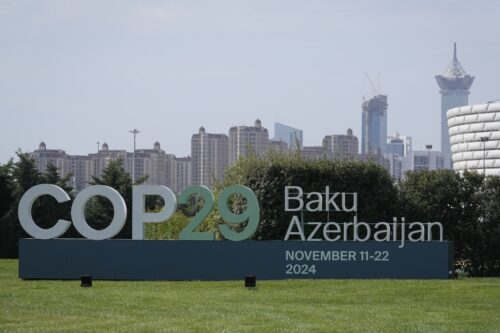COP29: Crucial moments as Baku’s climate confab begins

By Aliu Akoshile
There is palpable anxiety around the world as the global climate summit, Conference of Parties (COP29) of the United Nations Framework Convention on Climate Change (UNFCCC) begins today.
The two-weeks summit, holding in Baku, the capital city of the Republic of Azerbaijan, on the theme – in solidarity for a green world – will be attended by an estimated 50,000 participants from over 100 countries across the continents.
Unlike the recent past summits that were graced by heads of government, NatureNews learnt that the Baku conference may suffer low attendance by the political leaders.
One of the leaders who will be absent in Baku is the Brazilian President, Luiz Inacio Lula da Silva, whose country is the host-designate for COP30 next year. President da Silva was believed to have sustained domestic accidents a few days ago, which will prevent him from attending the Baku summit.
Similarly, heads of government of countries at the twilight of transition, such as the US President, Joe Biden, would be missing in Baku.
Another significant source of anxiety is the coincidental overlap between the dates of COP29, from November 11 to 22, and the summit of G20 leaders, from November 18 to 19, which also has climate transition financing as agenda item.
Notwithstanding the seeming setback due to the anticipated paucity of high-level attendance, President of Azerbaijan, Ilham Aliyev, justified the selection of his country as the host of COP29.
“Azerbaijan is committed to developing its renewable energy potential, which is an important part of the country’s plan to reduce greenhouse gas emissions by 40% by 2050.
“The country intends to increase renewable power capacity to 30% by 2030 and diversify its existing energy system to become a leader in green energy. Azerbaijan is committed to leading by example and will update its national targets in its next 1.5-aligned Nationally Determined Contribution
Also, the UN Climate Change boss, Simon Stiell was optimistic that “COP29 must be an enabling COP, delivering concrete outcomes to translate the pledges made in last year’s historic UAE Consensus into real-world, real-economy results.”
The COP29 President, Mukhtar Babayev, was also enthusiastic about the positive outcomes of the summit based on a robust plan for inclusion being introduced for the first time at the COP.
He said he was “listening to and engaging with a broad range of international stakeholders. It is working to ensure everyone’s voices are heard and perspectives are considered and included so that we deliver inclusive outcomes based on shared solutions. We are optimistic that together we can make real progress.”
With measured optimism, stakeholders expect the summit to culminate in the signing of Baku Agreement on a new finance target to help developing countries cope with the effects of global warming.
Other major highlights of COP29 are negotiations around energy transition, climate finance as well as loss and damage fund, which make stakeholders describe the Baku confab as the ‘Finance COP’.
Essentially, developing countries have to renegotiate the stillbirth commitment made by developed countries for $100 billion annual funding effective 2020.
A point of disagreement is the definition of the funds as some developing countries want grant funds that they don’t have to repay, whereas the developed countries are keen to give facilitate funding at a concessional interest rate in single digit.
NatureNews notes that although the loss and damage fund was one of the outcomes of COP21 held in Paris in 2015, it was not fully activated until the COP27 in Egypt in 2022 after which the Fund for Responding to Loss and Damage (FRLD) was set up and domiciled with the World Bank.
While experts project that about $580 billion will be needed for climate action by developing countries, a group of developed countries last year only pledged $700 million at the COP28 in Dubai.
Delegates at COP29 must be ready to discuss carbon credit and structure of its markets and the mechanism of financing climate action based on Paris Agreement Crediting Mechanism which allows a company in one country to reduce emissions and have those reductions credited, so that it can sell them to a company in another country which then add it up to meet its net-zero targets.
Analysts have projected that national delagates at COP29 will be interested in the Biennial Transparency Reports (BTR) agreed upon at the Paris conference, which is now due for submission by December 31, 2024.
Countries that are signatories to the agreement are to submit BTR every two years, in which they will provide information on progress against their own Nationally Determined Contributions (NDC) policies and measures, climate change impacts and adaptation, levels of financial, technology development and transfer, and capacity-building support, and needs and areas of improvement.
